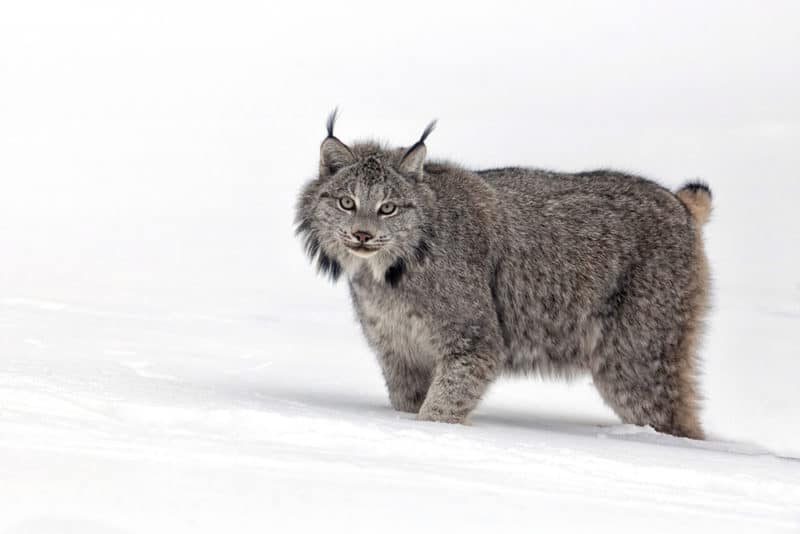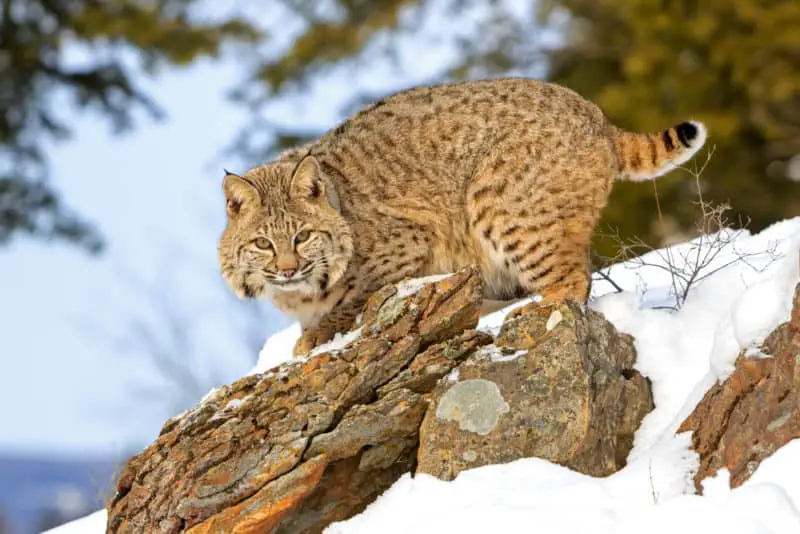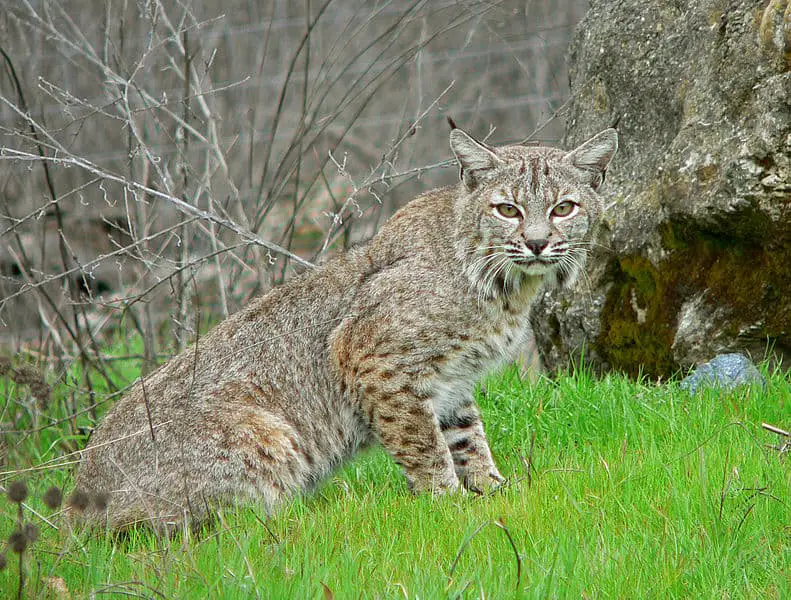The Bobcat and the Canadian Lynx are both members of the cat (Felidae) family and the Lynx genus. They share many physical and behavioral characteristics. But these two small wildcats have significant differences that help them thrive in their native habitats. This article discusses Bobcats and Canada Lynx’s similarities and differences and answers some frequently asked questions about these North American wildcats.

Canadian Lynx Characteristics
Diet
Canadian Lynx primarily hunt and eat snowshoe hares, but they adapt to a more varied diet in the southern part of their range. These cats are the only wildcats to show a prey-driven population variation because they rely almost entirely on the snowshoe hare for meat. If the snowshoe hare population diminishes, the Lynx population declines approximately two years later.
Range
Alaska and Canada have the most Canadian Lynx. In the continental United States, they live in Washington, Idaho, Montana, Minnesota, New Hampshire, and Maine. You’ll find lynx wherever snowshoe hares live.
Home ranges in the United States may run between 12 and 83 square miles. In Maine, where snowshoe hare densities are currently high, territories average 22 square miles for males and 10 square miles for females. Home ranges are larger in winter than in summer. They prefer boreal forests or mixed forests but can live in farmlands and near urban areas. Like all wild animals, they have lost much of their territory to humans. Canadian Lynx are sometimes found near human populations where the local snowshoe hare population is high.
Social Behavior and Mating
These wildcats are territorial, solitary, and primarily nocturnal. They mate in the late winter and early spring, generally from March to April. Female Canadian Lynx only mate with one male each season, and typical litters range from one to six kittens.
The kitten’s eyes open in about two weeks, and they can walk at about a month old. The kittens stay with their mother until the next mating season. When food is abundant, Canadian Lynx can reach sexual maturity at just under a year old.

Bobcat Characteristics
Diet
Bobcats have a varied diet, but they do eat a lot of rabbits. They also eat snakes, birds, and agricultural pests. Bobcats are not particular about their diet, and they eat what is available. They can hunt prey up to ten times larger than themselves and successfully kill a deer in the right circumstances.
Range
These cats live from southern Canada to Northern Mexico. Like the Canadian Lynx, they are found only in North America. Bobcats have a home range of about two square miles on average. They prefer wooded areas and mountainous areas where they can hide easily, although they can live near human populations. They frequently live near farmlands where they can prey on agricultural pests.
Social Behavior and Mating
Although Bobcats are solitary and territorial, they tend to venture out in the daylight more frequently than Canadian Lynx. Bobcats mate from December to April. While a male might breed with more than one female, the female Bobcat only breeds with one male. Litters range from one to six kittens.
These kittens can open their eyes at about nine days and walk when they are about a month old. Like Canadian Lynx kittens, Bobcat kittens stay with their mothers until the next mating season. Sexual maturity for females is one year and two years for males.
What is the difference between a bobcat and a Canadian lynx?
These two wildcats share a narrow territory on the United States and the Canadian border. If you are lucky enough to glimpse one of these animals in this area, you might have difficulty deciding if you saw a Canadian Lynx or a Bobcat. The following information can help you tell the difference between these two wildcats.
Bobcat vs. Canadian Lynx

Bobcat 
Lynx
| Bobcat | Lynx | |
|---|---|---|
| Species Name | Lynx Rufus | Lynx Canadensis |
| Height | Approx. 53 cm (21″) | 60-65 cm (24-26″) |
| Weight | 6-13 kg (13-29 lbs) | 5-17 kg (13-29 lbs) |
| Tail Length | 9-11 cm (3.5-4.3″) | 5-12 cm (2-5″) |
| Tail Color | Tip black on top, white underneath. | Entirely black tip. |
| Black Ear Tuft | Short and can be absent. | Long, more noticeable. |
| Coat color | Reddish-brown, distinct spotting. | Gray, indistinct spotting. |
| Legs | Shorter legs, all legs roughly the same height. | Long legs, back legs longer than front legs. |
| Feet | Smaller paws and shorter back feet. | Heavily padded paws and longer back feet. |
| Diet | A varied diet, including birds and snakes. | Primarily Snowshoe Hares. |
| Disposition | More aggressive. | Less aggressive, gentler. |
| Facial Ruff | Smaller flared ruff. | Larger flared ruff. |
Frequently Asked Questions – North American Wildcats
Are Bobcats and Canadian Lynx endangered?
Neither of these wildcats is classified as endangered at this point. Their conservation status is Least Concern, and each of these wildcats provides fur for the managed fur trade.
In the lower 48 states of the United States, the Canadian Lynx is Threatened, with stable lynx populations below the Canadian border only in Maine, Montana, Washington, and Colorado. Canadian Lynx are rare and protected in southeastern Canada. They are regionally classified as Endangered in Nova Scotia and New Brunswick.
The Bobcat is regionally Protected in ten U.S. states and some areas of Mexico.
What is the average lifespan of the Canadian Lynx?
A captive Canadian Lynx can live up to 21 years. In the wild, these cats live about 15 years. A captive Bobcat can live up to 33 years, but in the wild, Bobcats live about 12-13 years.
How do Bobcats and Canadian Lynx Hunt?
Bobcats are sneaky predators, hiding and pouncing up to ten feet to deliver a blow that kills their prey. They can kill resting deer, and they slap rattlesnakes into quiet submission to eat them.
Canadian Lynx are stealthy hunters. Their ear tufts amplify their hearing, and their excellent eyesight enables them to see prey up to 250 feet away. Lynx are solitary night hunters who wait for hares and then pounce, sometimes eating an entire snowshoe hare for a meal. Canadian Lynx can jump 25 feet to reach their prey.
How do Canadian Lynx walk on snow?
Canadian Lynx have long back legs and paws that spread as they step on snow. Their heavily padded paws have thick fur that helps them work as natural snowshoes.
What is a Blue Lynx?
The Blue Lynx is a rare Canadian Lynx with fur that appears pale bluish, perhaps resulting from partial albinism.
Are Bobcats aggressive?
Bobcats are much more aggressive and cantankerous than Canadian Lynx. Their aggression may contribute to their ability to thrive as their natural habitat diminishes.
How do Bobcats kill their prey?
Bobcats are as lethal as they are aggressive. They pounce to capture their prey and bite the neck, skull, or throat to kill it. Bobcats are known to slap rattlesnakes into dazed states so they can feed on them.
Do Bobcats eat rattlesnakes ?
The answer is yes, although they have no immunity to rattlesnake venom. They use their quickness and agility to outmaneuver the snake.
There is a viral video found online that shows the technique that they employ.
Are Bobcats Dangerous To Humans?
There are no known cases of Bobcats regarding humans as prey animals. They are, however, tough and fierce. They’re also equipped with sharp teeth and claws.
A rabid Bobcat would defiantly be dangerous to humans. A bobcat that thinks you have it cornered would also be dangerous. If you run into a bobcat in the wild, defiantly give it a wide berth.
Can a Bobcat and Lynx mate?
The answer to this question is yes. Bobcat/Lynx hybrids are observed in the wild occasionally. In one example, in 2003, two suspected hybrids in Maine were captured. Their DNA was collected and sent to the Forest Service’s Genetics lab in Missoula, Montana, where they were confirmed to be Bobcat /Lynx hybrids. Source
Its A Rare Occurrence To See A Lynx Or A Bobcat
They’re shy of humans and very stealthy in their environment. You can still look for signs of their passing through. Bobcat tracks look like a small K9 except for the absence of any claws. They also have a groove that goes through the middle of their main pad. Bobcat tracks are about 1 1/2″ long by 1 3/8″ wide. Source
Lynx tracks are similar in appearance to Bobcat tracks. They’re much larger, though. A Lynx track is about 5″ across. Source
Even if I don’t get to see one, seeing their tracks and knowing they’re close by somewhere doing their thing. Perhaps watching me makes my time in the outdoors that much richer.
Recent Posts
The only venomous snakes in Washington State are Northern Pacific Rattlesnakes. The Northern Pacific Rattlesnake (Crotalus oreganus oreganus) is a sub-species of the Western Rattlesnake. Anyone...
Skunks are not classified as true hibernators. But they go into a state of torpor when the weather gets cold. Skunks are light sleep hibernators, along with opossums, bears, and raccoons. ...

